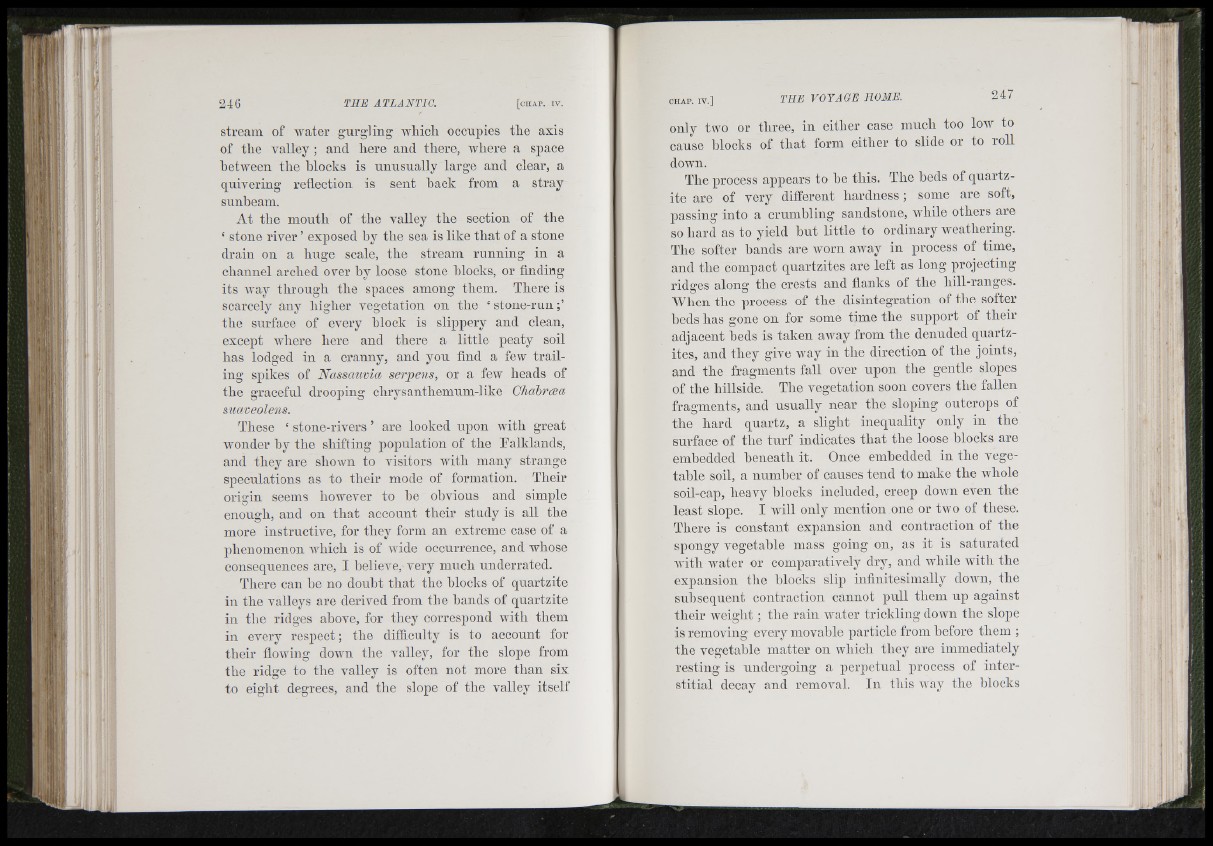
■Ill
m
I!*
stream of water gurgling aa'IiIcIi occupies tlie axis
of the A'alley ; and here and there, where a space
hctwecn the blocks is nnusually large and clear, a
qnwering reflection is sent back from a stray
sunbeam.
At the mouth of the valley the section of the
‘ stone river ’ exposed by the sea is like th a t of a stone
drain on a huge scale, the stream running in a
channel arched over by loose stone blocks, or finding
its Avay through the spaces among them. There is
scarcely any higher vegetation on the ‘ stone-run
the surface of CA'cry block is slippery and clean,
except Avhere here and there a little peaty soil
has lodged in a cranny, and yon find a few tra iling
spikes of Nasscmvia serpens, or a few heads of
the graceful drooping chrysanthemnm-like CJiah'cBa
suaveolens.
These ‘ stone-rivers ’ are looked upon Avith great
wonder hy the shifting population of the Ealklands,
and they are shown to visitors with many strange
speculations as to their mode of formation. Their
origin seems however to he obvious and simple
enough, and on th a t account their study is all the
more instructive, for they form an extreme case of a
phenomenon Avhich is of Avide occurrence, and whose
consequences are, I believe, very much underrated.
There can he no doubt th a t the blocks of quartzite
in the valleys are derived from the hands of quartzite
in the ridges ahove, for they correspond Avith them
in every respect; the difficulty is to account for
their floAving doAvn the valley, for the slope from
the ridge to the valley is often not more than six
to eight degrees, and the slope of the valley itself
only two or three, in either case mnch too Ioav to
cause blocks of th a t form either to slide or to roll
doAvn.
The process appears to he this. The beds of q uartzite
are of very different h a rd n e ss; some are soft,
passing into a crumbling sandstone, while others are
so bard as to yield b u t little to ordinary Aveatbering.
The softer bands are Avorn aAvay in process of time,
and the compact qnartzites are left as long projecting
ridges along the crests and flanks of the hill-ranges.
When the process of the disintegration of the softer
beds has gone on for some time the support of their
adjacent beds is taken aAvay from the denuded qnartzites,
and they give way in the direction of the joints,
and the fragments fall over upon the gentle slopes
of the hillside. The vegetation soon covers the fallen
fragments, and usually near the sloping outcrops of
the hard quartz, a slight inequality only iu the
surface of the tu rf indicates th a t the loose blocks are
emhedded beneath it. Once embedded in the vegetable
soil, a number of causes tend to make the whole
soil-cap, heavy blocks included, creep down even the
least slope. I Avill only mention one or tAvo of these.
There is constant expansion aud contraction of the
spongy vegetable mass going on, as it is saturated
Avith Avater or comparatively dry, and Avhile with the
expansion the blocks slip infinitesimally doAvn, the
subsequent contraction cannot pull them up against
their w e ig h t; the rain water trickling down the slope
is removing every movable particle from hefore them ;
the vegetable matter on Avhich they are immediately
resting is undergoing a perpetual process of interstitial
decav and removal. In this AAuy the blocks